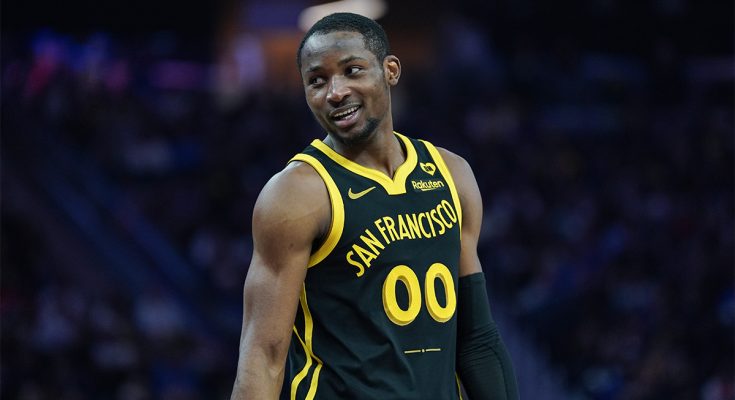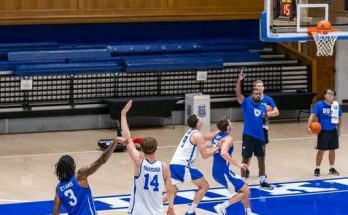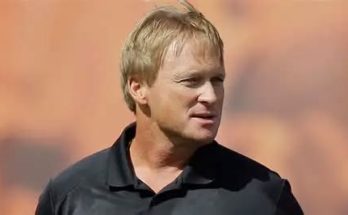The Golden State Warriors are no strangers to high-stakes moments, but a new layer of tension is emerging that has nothing to do with game-winning shots or playoff series. Instead, it revolves around the contract situation of Jonathan Kuminga, a player who has grown from a promising lottery pick into a crucial component of the franchise’s future. And now, according to an unnamed NBA executive, the Warriors could be “f–ked” if Kuminga chooses to accept his qualifying offer instead of agreeing to a long-term extension. While that comment is brash and dramatic, the implications behind it are anything but empty.
Kuminga’s development in Golden State has been a slow burn with flashes of brilliance that suggest superstar potential. Drafted seventh overall in 2021, Kuminga spent his rookie and sophomore seasons playing behind veterans like Draymond Green and Andrew Wiggins, absorbing the intricacies of Steve Kerr’s system while showing off his athletic gifts in bursts. The 2023–24 season was expected to be a make-or-break campaign for him, and he responded with his best year yet—posting career-highs in points, rebounds, and minutes while cementing himself as one of the few young bright spots on an aging Warriors roster.
With that kind of momentum, the Warriors are naturally inclined to offer Kuminga a significant extension. He’s the type of two-way, hyper-athletic forward who could bridge the gap between the Stephen Curry era and whatever comes next. But things get murky when you factor in the money, the team’s cap situation, and Kuminga’s own ambitions. Under the current rules of restricted free agency, Kuminga can either accept a qualifying offer from Golden State—essentially a one-year “prove-it” deal that would make him an unrestricted free agent in 2026—or he can negotiate a longer-term contract. It’s the former scenario that has reportedly sent shivers down the spine of some NBA insiders.
Accepting the qualifying offer would mean Kuminga is betting on himself in the most high-risk, high-reward way possible. It would also mean the Warriors are one season away from potentially losing him for nothing in return. For a franchise already squeezed by the luxury tax, staring down difficult decisions about the futures of Klay Thompson, Draymond Green, and eventually Curry, losing a 21-year-old future cornerstone without any compensation would be a devastating blow. That’s the real reason the anonymous executive’s quote has gained so much traction. It’s not just profanity for the sake of headlines—it reflects a genuine concern about the Warriors’ position in a high-stakes game of contract chicken.
The Warriors’ financial situation complicates things further. They’re already over the salary cap and facing second-apron tax penalties that limit roster flexibility. Giving Kuminga the kind of money he’s likely to command—something in the ballpark of four years, \$100 million—would add another massive financial commitment to an already bloated payroll. Yet the alternative is even worse: letting Kuminga test unrestricted free agency after 2025–26 and risk watching him walk away for nothing, just as many other promising young players have done elsewhere in the league.
Historically, players rarely accept their qualifying offers. The reason is simple: guaranteed money and long-term security usually trump the risk of a single-year deal with no protection against injury or regression. But there are exceptions, and Kuminga could be one of them. His camp may believe that a bigger payday awaits him after a breakout 2024–25 season, especially if he continues to show that he can carry a heavier offensive load while playing elite-level defense. From that perspective, taking the qualifying offer could be a calculated gamble with massive upside.
There’s also a psychological aspect to all of this. If Kuminga does accept the qualifying offer, it sends a signal—not just to the Warriors but to the entire league. That signal is: “I’m not tied to this team long-term.” For a franchise trying to build trust with its young stars and transition smoothly into the next era, that message is deeply problematic. It could affect locker room chemistry, coaching decisions, and even the trade market, as teams would be hesitant to give up major assets for a player who may be a flight risk within a year.
The Warriors have been through similar situations before. Kevin Durant’s exit in 2019 was a gut punch, but it came after multiple championships and mutual respect. This would feel different. Losing Kuminga in such a manner would be a failure of foresight and asset management. It would suggest that Golden State had the right piece in its grasp and fumbled it—not because of talent, but because of an inability to make the financials and relationship work.
It’s also worth noting that Kuminga himself has hinted at frustrations in the past, particularly regarding playing time and role clarity. While those tensions seemed to ease last season as his minutes increased, the underlying issues may not be entirely resolved. Kuminga is a competitor, and like many young stars, he wants to be more than a role player. He wants to lead, to star, and to be trusted with the game on the line. If he feels like Golden State isn’t willing to build around him—or at least make him a central figure in their plans—that could further motivate him to seek freedom after the 2025–26 campaign.
So where do the Warriors go from here? Ideally, both sides find common ground on a deal that rewards Kuminga’s growth while protecting the team’s long-term financial health. Something like a four-year, \$90–100 million extension with performance incentives could strike that balance. But extensions aren’t just about numbers—they’re about relationships, vision, and buy-in from both sides. If Kuminga’s camp is lukewarm on the Warriors’ future direction, even a fair offer might not be enough to avoid the qualifying offer scenario.
There’s also the trade wildcard. If Golden State gets the sense that Kuminga won’t commit long-term, they may explore the trade market before the deadline. The return would have to be significant—think multiple picks or a star-level player—but it would be better than letting him walk for nothing. However, such a move would come with its own risks. Trading Kuminga now could look foolish if he blossoms into a star elsewhere, especially if the return doesn’t pan out.
It’s a delicate tightrope, one that requires shrewd front-office maneuvering, honest conversations with the player and his camp, and a unified organizational vision. The Warriors have the championship pedigree and front-office experience to navigate these waters, but this situation is unlike anything they’ve faced in recent years. The Curry, Thompson, and Green era was defined by harmony, cohesion, and mutual loyalty. This next chapter will require a new set of tools—starting with the ability to retain the talent they’ve worked so hard to develop.
Meanwhile, Kuminga holds a fair amount of leverage. His breakout season didn’t go unnoticed across the league. Teams with cap space in 2026 will be watching closely, especially rebuilding franchises eager to add a versatile, high-upside forward entering his prime. If Kuminga believes his future is brighter outside of San Francisco, and the Warriors can’t convince him otherwise, the groundwork for a breakup is already being laid—one that could reshape Golden State’s trajectory for years.
That’s why the unnamed NBA executive’s quote struck such a chord. It captured the anxiety, urgency, and potential fallout of a seemingly simple contract decision. If Kuminga accepts the qualifying offer, it won’t just be about money. It will be a referendum on the Warriors’ ability to adapt, evolve, and retain elite young talent in a changing NBA landscape. And yes, in that scenario, “f–ked” might not be too strong a word after all.



